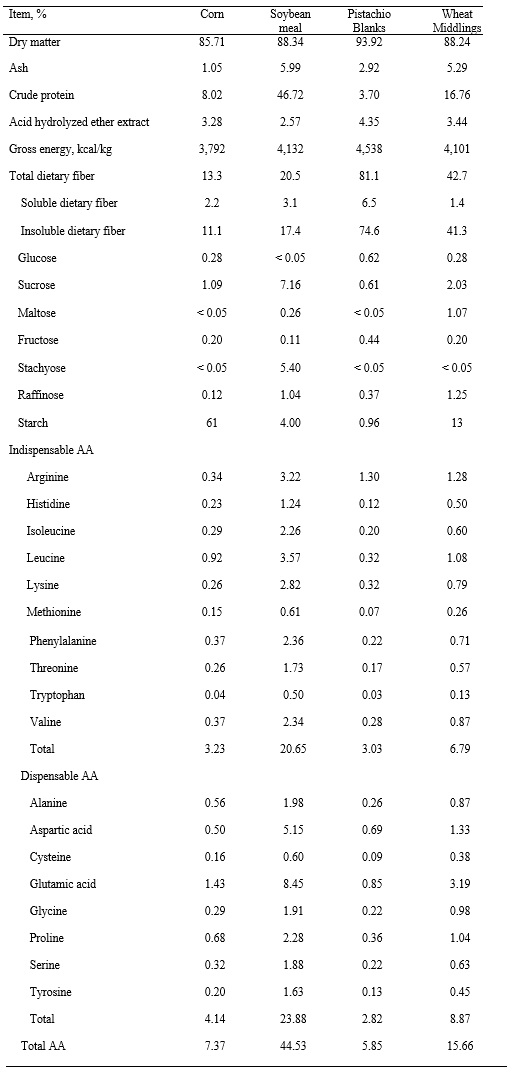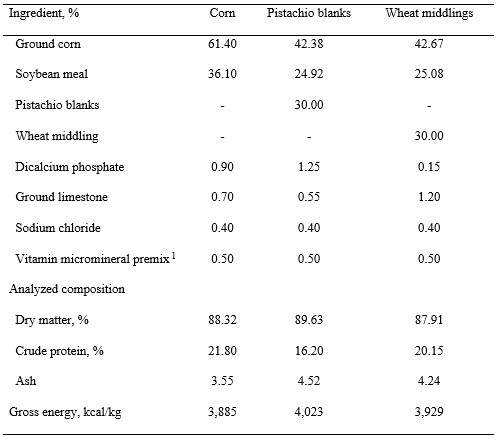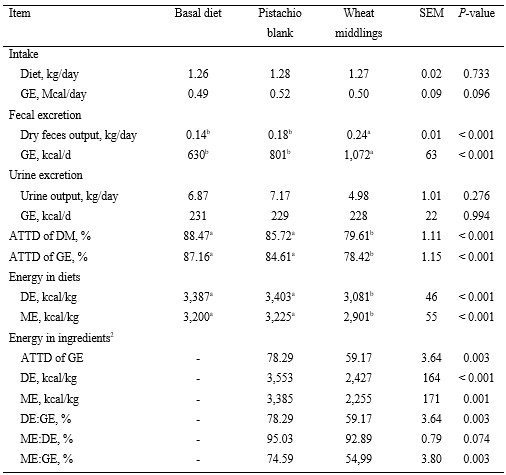As the production of pistachios grows globally, more co-products are produced every year. Pistachio blanks are pistachio fruits that float in water because the shells are hollow and therefore cannot be used for human food. Pistachio blanks is a high fiber ingredient, which is comparable to wheat middlings. The annual production is 50,000 to 70,000 tons, but is growing. Pistachio blanks have been viewed as a waste product from the pistachio processing sector, but it is possible this feed ingredient can provide nutrients for animals and be used in animal diets. Therefore, this experiment was conducted to test the hypothesis that the apparent total tract digestibility of energy, dry matter, ash, and total dietary fiber in pistachio blank powder is not different from that of wheat middlings if included in diets for growing pigs.
Experimental Design
Three diets were formulated. The control diet was based on corn and soybean meal and two additional diets were formulated by adding 30% pistachio blanks or 30% wheat middling to the control diet. Vitamins and minerals were included in all diets to meet or exceed the estimated requirements for growing pigs (NRC, 2012).
Animals, housing, feeding and sample collection
Twenty-four growing pigs (initial body weight (BW): 23.01 ± 0.90 kg) were allotted to a completely randomized design with three diets and eight replicate pigs per diet. Pigs were housed individually in metabolism crates (0.81 m × 1.52 m) that were equipped with a self-feeder, a nipple waterer, and a fully-slatted floor. A screen and a urine pan were placed under the slatted floor to allow for the total, but separate, collection of urine and fecal materials. Pigs were limit-fed at 3.0 times the maintenance requirement for ME (i.e., 197 kcal/kg × weight0.60; NRC, 2012), which was provided each day in two equal meals at 0800 and 1600 h. Throughout the experiment, pigs had free access to water. Pigs were fed experimental diets for 13 days, with feed consumption recorded daily. The initial seven days were considered the adaptation period to the diet. Urine and fecal materials were collected from the feed provided during the following four days according to standard procedures using the marker to marker approach (Adeola, 2001). Urine was collected in urine buckets over a preservative of 50 mL of hydrochloric acid from day 8 to day 12. Fecal samples and 10% of the collected urine were stored at −20 °C immediately after collection.
Ingredients, diets, and fecal samples were analyzed for dry matter. Diets and ingredient samples, fecal samples, and lyophilized urine samples from growing pigs and gestating sows were analyzed for GE on an isoperibol bomb calorimeter. Ingredients were analyzed for insoluble dietary fiber, soluble dietary fiber, amino acids.
The statistical model included diet or ingredient as the fixed effect and block and replicate within block were random effects. Least square means were calculated, and means were separated using the pdiff option with the Tukey’s adjustment if the model P-value was significant. Significance was considered at P < 0.05 and a tendency was considered at P < 0.10. To compare growing pigs, gestating sows, and lactating sows, data were analyzed using ANOVA. Within each ingredient, the statistical model included physiological status as the fixed variable. Least square means were calculated, and means were separated using pdiff with the Tukey’s adjustment if the model P-value was significant.
Results
Pigs remained healthy during the experiment and feed refusals were not observed. All animals completed the experiment. Feed intake and GE intake by pigs fed the three experimental diets were not different. Dry feces output and GE fecal output from pigs fed the pistachio blanks diet were less (P < 0.05) than from pigs fed the wheat middlings diet, but not different from that of pigs fed the basal diet. Urine output and GE urine output from pigs were not different regardless of which diet was provided. The ATTD of DM and GE as well as DE and ME were less (P < 0.05) for the wheat middlings diet than for the other diets, but no difference was observed between the basal diet and the pistachio blank diet. The DE and ME were less (P < 0.05) in wheat middlings than in pistachio blanks, and the DE:GE and the ME:GE were also less (P < 0.05) in wheat middlings than in pistachio blanks.
Conclusion
Pistachio blanks is a high fiber ingredient, but the fiber is highly fermentable and pistachio blanks, therefore, contain more DE and ME than wheat middlings. It is likely that pistachio blanks can be used as a high fiber ingredient in diets for growing pigs.
Appreciation
Funding for this research form the Wonderful company (Los Angeles, CA) is greatly appreciated.
Table 1. Analyzed nutrient composition of feed ingredients, as-is basis

Table 2. Composition (as-is basis) of experimental

1The vitamin-micromineral premix provided the following quantities of vitamins and micro minerals per kg of complete diet: vitamin A as retinyl acetate, 10,622 IU; vitamin D3 as cholecalciferol, 1,660 IU; vitamin E as selenium yeast, 66 IU; vitamin K as menadione nicotinamide bisulfate, 1.40 mg; thiamin as thiamine mononitrate, 1.08 mg; riboflavin, 6.49 mg; pyridoxine as pyridoxine hydrochloride, 0.98 mg; vitamin B12, 0.03 mg; D-pantothenic acid as D-calcium pantothenate, 23.2 mg; niacin, 43.4 mg; folic acid, 1.56 mg; biotin, 0.44 mg; Cu, 20 mg as copper chloride; Fe, 123 mg as iron sulfate; I, 1.24 mg as ethylenediamine dihydriodide; Mn, 59.4 mg as manganese hydroxychloride; Se, 0.27 mg as sodium selenite and selenium yeast; and Zn, 124.7 mg as zinc hydroxychloride.
Table 3. Apparent total tract digestibility (ATTD) of dry matter (DM) and gross energy (GE) and concentrations of digestible energy (DE) and metabolizable energy (ME) in experimental diets fed to growing pigs1, as-fed basis

a-cWithin a row, means without a common superscript differ (P < 0.05).
1Each least square mean represents 8 observations per diet.